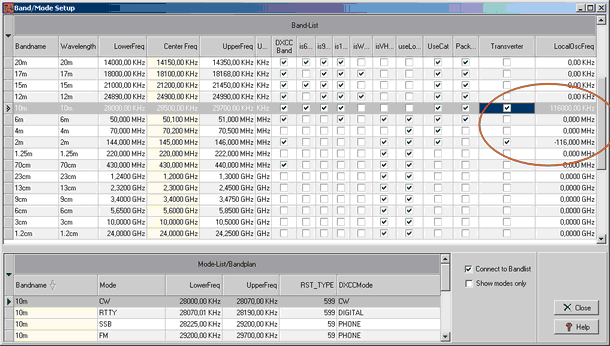A transverter is a hardware device which typically shifts a segment of a short wave band into the VHF or UHF regions. This is an interesting feature since it allows to use all of the fancy properties of good short wave transceivers on VHF or UHF as well.
Mostly the 2-MHz segment of the 10m band (= base band) will be transverted onto the 6m or 2m band (= target band). The task in TurboLog 4 is to manipulate the frequency and band readings of the base band in case of a transverter operation. This means in case of a 2m-transverter , e.g. a base band frequency of 28100KHz will be interpreted as 144100KHZ and vice versa. Thus frequency readings will have to be manipulated by internally adding or subtracting an offset of 116000.000KHz, respectively.
This operation is controlled by suitable entries in the Bands & Modes table. Following the given example the entries as shown below will have to be provided by the user:
It is important to note:
1.The base band has to be checked and the local oscillator frequency given with positive (=no) sign in correct units ( here: KHz).
2.The target band has to be checked and the local oscillator frequency given with negative sign in correct units ( here: MHz).
3.There are no other actions provided by TurboLog 4 than band and frequency corrections throughout the whole program, e.g. for logging, CAT control, grabbing and sending packet spots, drag & drop actions, etc. There is in particular no hardware control for the setup of the base band transceiver and transverter.
4.Cat-operation is mandatory for transverter operation.
5.The user must be aware of the frequency translation for the base band as long as the Transverter items are checked in the Bands & Modes table.
Customization of the Bands & Modes table is described in greater details in a separate paragraph under the Edit Menu.
Active COMMANDS:
KEYS:
| EDIT | F2-key, or right mouse key click for context menu |
| INSERT | Inserts a new row above highlighted row. |
| DELETE | Deletes a selected field. |
| Ctrl+DELETE | Deletes the whole row. You are prompted before execution. |
MOUSE:
| LEFT KEY CLICK on row | Selects/highlights this particular row. |
| LEFT KEY CLICK on highlighted field | Opens field for editing...or....inverts the status of a checkbox field. |
| LEFT KEY CLICK on separator of caption | Starts drag mode to adjust field width. |
| LEFT KEY CLICK on caption | Selects column and its content for sorting whole table. |
| RIGHT KEY CLICK on caption | Starts drag mode to move whole column. |
| RIGHT MOUSE KEY over grid | Pops up context menu |
CLICKABLES and HOTSPOTS:
BUTTONS:
| DELETE | Deletes selected item, prompts before execution. |
| ACCEPT | Accepts selected configuration. |
| CANCEL | Cancels all changes and editing made so far. |
| CLOSE | Closes focussed frame. |
| HELP | Opens (this) help window. |
| RESET WIDTH | Resets field widths to factory defaults. |
| FIT TO GRID | Arranges columns to best fit to window size. |
This topic was last edited on Thursday, 12-Dec-2024, at 13:30
